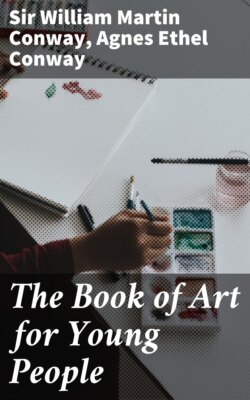The Book of Art for Young People

Реклама. ООО «ЛитРес», ИНН: 7719571260.
Оглавление
Agnes Ethel Conway. The Book of Art for Young People
The Book of Art for Young People
Table of Contents
THE CHILDREN'S BOOK. OF ART
CHAPTER I
INTRODUCTORY
CHAPTER II
THE THIRTEENTH CENTURY IN EUROPE
CHAPTER III
RICHARD II
CHAPTER IV
THE VAN EYCKS
CHAPTER V
THE RENAISSANCE
CHAPTER VI
RAPHAEL
CHAPTER VII
THE RENAISSANCE IN VENICE
CHAPTER VIII
THE RENAISSANCE IN THE NORTH
CHAPTER IX
REMBRANDT
CHAPTER X
PETER DE HOOGH AND CUYP
CHAPTER XI
VAN DYCK
CHAPTER XII
VELASQUEZ
CHAPTER XIII
REYNOLDS AND THE EIGHTEENTH CENTURY
CHAPTER XIV
TURNER
CHAPTER XV
THE NINETEENTH CENTURY
INDEX
Отрывок из книги
Agnes Ethel Conway, Sir William Martin Conway
Published by Good Press, 2019
.....
The people liked to see their Old Testament stories and the stories from the Life of Christ painted over and over again. They had become fond of the versions of the tales which they had known and seen painted when they were young, and did not wish them changed, so that the range of subjects was not large. The same were repeated, and because of the painter's fear of making mistakes it was natural that the same figures should be repeated too. Thus, whatever the subject pictured, a tradition was formed in each locality for the grouping and general arrangement of the figures, and the most authoritative tradition for such typical groupings was preserved in Constantinople or Byzantium, from which city the 'Byzantine' school of painting takes its name.
Before 1200, Byzantium had been a centre of residence and the civilizing influence of trade for eighteen centuries. It had been the capital of the Roman Empire, and less civilized peoples from the north had never conquered the town, destroying the Greek and Roman traditions, as happened elsewhere in Europe. You have read how the Romans had to withdraw their armies from England to defend Rome against the attacks of the Goths from the north, and then how Britain was settled by Angles, Saxons, Jutes, and Danes, who destroyed most of the Roman civilization. A similar though much less complete destruction took place in Italy a little later, when Goths and Lombards, who were remotely akin to the Angles and Saxons, overwhelmed Roman culture. But next to Constantinople, Rome had the best continuous tradition of art, for the fine monuments of the great imperial days still existed in the city. In Byzantium the original Greek population struggled on, and continued to paint, and make mosaics, and erect fine buildings, till the Turks conquered them in 1453. The Byzantines were wealthy and made exquisite objects in gold, precious stones, and ivory. While they were painting better than any other people in Europe, they too reproduced the same subjects and the same figures over and over again, only the figures were more graceful than those of the local Italian, English, and French artists, who in varying degrees at different times tried to paint like the Byzantine or Greek artists, but without quite the same success. So long as there was no need for an artist to paint anything but the old well-established subjects, and so long as people desired them to be painted in the old conventional manner, there was little reason why any painter should try to be original and paint what was not wanted. But in the thirteenth century a great change took place.
.....